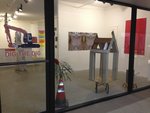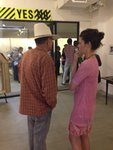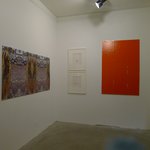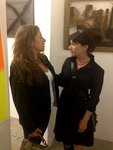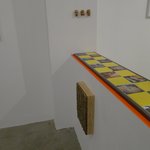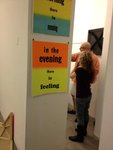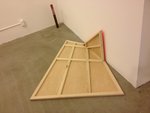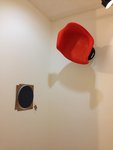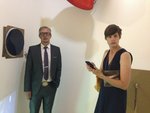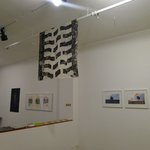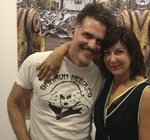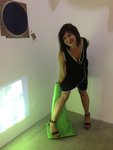A show about construction curated by Bettina Hubby at the LA Mart in conjunction with her project with The Santa Monica Museum of Art as their Resident Construction Artist
Opening reception: Thursday, May 30th, from 6-9pm
LA Mart exhibition dates: May 30th – June 29th, 2013
Maker City LA: 11th floor, 1933 S. Broadway, LA CA 90007
Closing reception: Friday, June 28th, from 6-9pm

THE LA MART—DOWNTOWN LA: Bettina Hubby presents DIG THE DIG, an exhibition curated with the theme of construction as its driving force. As Hubby’s project for The Santa Monica Museum of Art evolved, other artists came to mind who were currently working in ways that related to construction either literally, materially or metaphorically. As the list of artists grew, ideas for this this show evolved into a concrete reality.
Maker’s City LA on the 11th Floor of the LA Mart is an ideal home for this exhibit; it is under construction itself and in the process of becoming a major hub of artistic interaction, shared skills and community.
The Santa Monica Museum of Art: On Sunday, July 21, at the construction site outside of the museum, Hubby will host a candle-lit and disco-ball activated and potluck, DIG THE DIG Dinner, which will bring together construction workers, local business owners, and neighbors for a festive meal, music and performances by local artists.
Works in the exhibit:
Adelman’s photographs of roadside workers are blurred and split by hard lines of darkness, referring the imperfect and fragmented ways of seeing – and her scent piece (located on a shelf below) is made as an offering of protection and safety to the construction workers. * Arnold’s photograph documents “Gruezi, a nude performance where Arnold is submerged in the ground under glass surrounded by construction machinery, and engineers, in Basel, Switzerland. * Attie's piece California Dreamin' explores societies fixation on "The Princess" and how ultimately destructive and decisive this syndrome can be. * Beinner James pushes paint through porous fabric to dislodge and disrupt expectations about painting. Her video work attempts to model apprehension. * The process to make even something as simple as a circle can be long and messy and bothersome; Bowen’s piece shows the process of construction, the drips, and the waste and piles of rubble, can be beautiful. * Boysen’s shaped and expertly treated canvas looks as if it’s a part of some larger mechanic or architectural structure that’s been plied off and left as mysterious residue. * Calabrese’s paintings of holes in the ground are a part of an ongoing series that cluster around each other with their earth-drenched palettes and depictions of voids of dirt. * Callaghan’s rubbings employ charcoal on canvas to capture the burly essence of a construction worker’s truck tire. * Clements uses popcorn ceiling material to coat a sculptural companion for a handsome man, Ken Price in this case, who gazes from his rugged collage, referencing objectified beauty, and quietly outraged by the rude block before him. * Fowler’s, “A Spectacle is Nothing Strange,” is a public art project that includes 21 letterpress posters printed by Colby Posters. All of the text is from Gertude Stein’s “Tender Buttons” written in 1914. * Hardesty’s sculpture, based on sunlight passing through a window and the breaking shadow that it creates on the floor and wall, looks like the reverse side of a painting or a fractured stage set with an otherworldly aura of reflected color light cast on the wall around it. * Janes & Miller’s house-like structure of an unrealized architectural mold protects an ancient concrete gateway. * Jonesy gathered images of male workers that now grace the faces of an unconventional deck of cards – we view these slightly unclad and/or poised workers in their environments, and could play with them beyond the simple gaze. * Lofgren’s sculpture, part of her pole extrusion series, uses rubbery industrial materials and gory color to humanize the copper pole and protruding part in an eerily fleshy way. * By making full use of the range textures and physical properties, Lund's materials play an active collaborative role in the making of his sculptures. * Marnie’s drywall drawing was produced by gestures of destruction into its material to create a pattern of color in its gashes. * Mason’s triptych of photographs and post-it notes “Entropy in the Home” looks at energies and economies that flow between the home and workplace. * Michlig takes the caution sign as his launching point to subtly distort their norm in a series of YES’ and NO’s. * Petersen’s patterned statue rises from its multi-colored plinth against a painted backdrop – each in the triumvirate enhanced by the other’s presence. * Pickett photographed a tree at the edge of the SMMoA construction site, returned to the site with the print, then let the wind driven tree – with pens attached – make the drawing. * Porcari’s photo: the following of heavy praise for Touch Me in the Morning, the city of New York decided to repave the parking spaces directly in front of the Pussycat Theatre – this was in 1982. * Primé’s videos are obsessive compulsive in their play; she multiplies shapes derived from origami and exceeds their constructed size, resulting in flabby behavior. * Slack's installation of inkjet prints of his digital pictures, is best described by this quote: "Things constantly machinate within themselves and mesh with one another, acting and reacting to properties and states while still keeping something secret." —Ian Bogost (from Alien Phenomenology, or What It's Like to Be a Thing). * Stoll’s drawings of fragmented constructive shapes are tight and small on invisible landscapes, emanating a careful drama of architectural creation. * Stone’s chair, is a safety-orange-coated-Eames affixed to a bucket base that fits atop a bucket mount, honoring the Shaker ways by the chair’s retirement to the wall at the end of the work day. * The Modeling Agency’s piece is made from construction debris – it is a drawing, a sculpture and is the result of a kind of performative act. * Walsh’s large romantically constructed rock consists of a chain trailing off of it attaching to a smaller version of itself, and atop that a brightly colored paper flower. * Woods’ provocatively obfuscated movie poster has a large screw as its revealed focus; this sexually charged hardware evokes screwing and digging, appropriately.
- Also included will be photographs from two construction workers Hubby befriended and who inspired her by sending photos to her of their respective worksites, Juan Franco and Mike Berrian.

